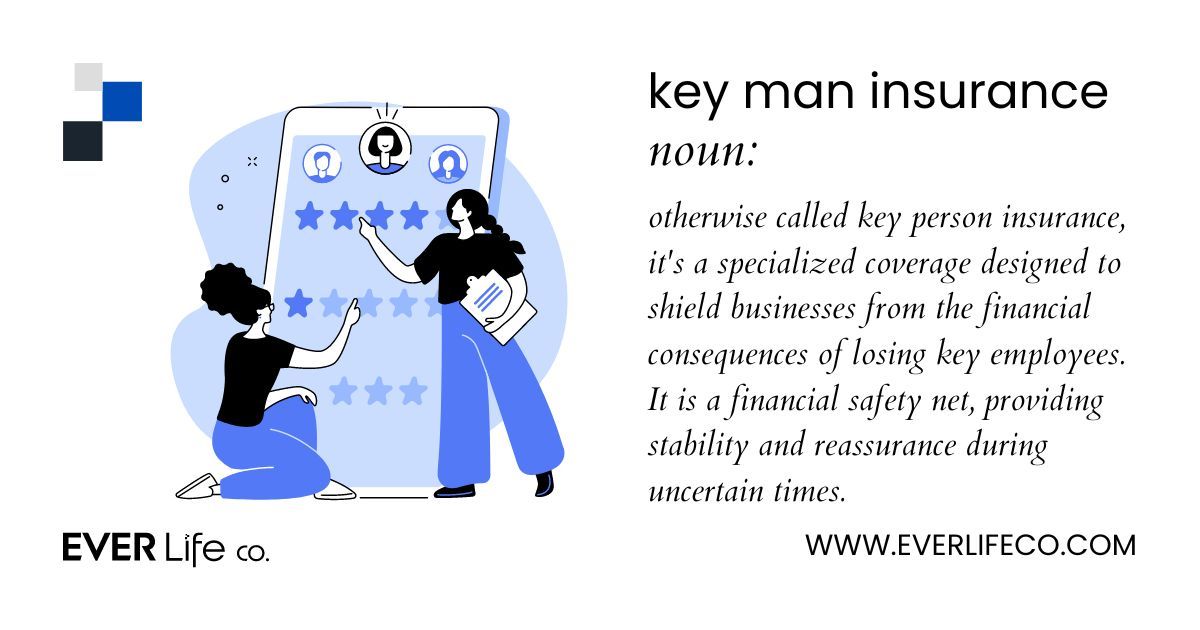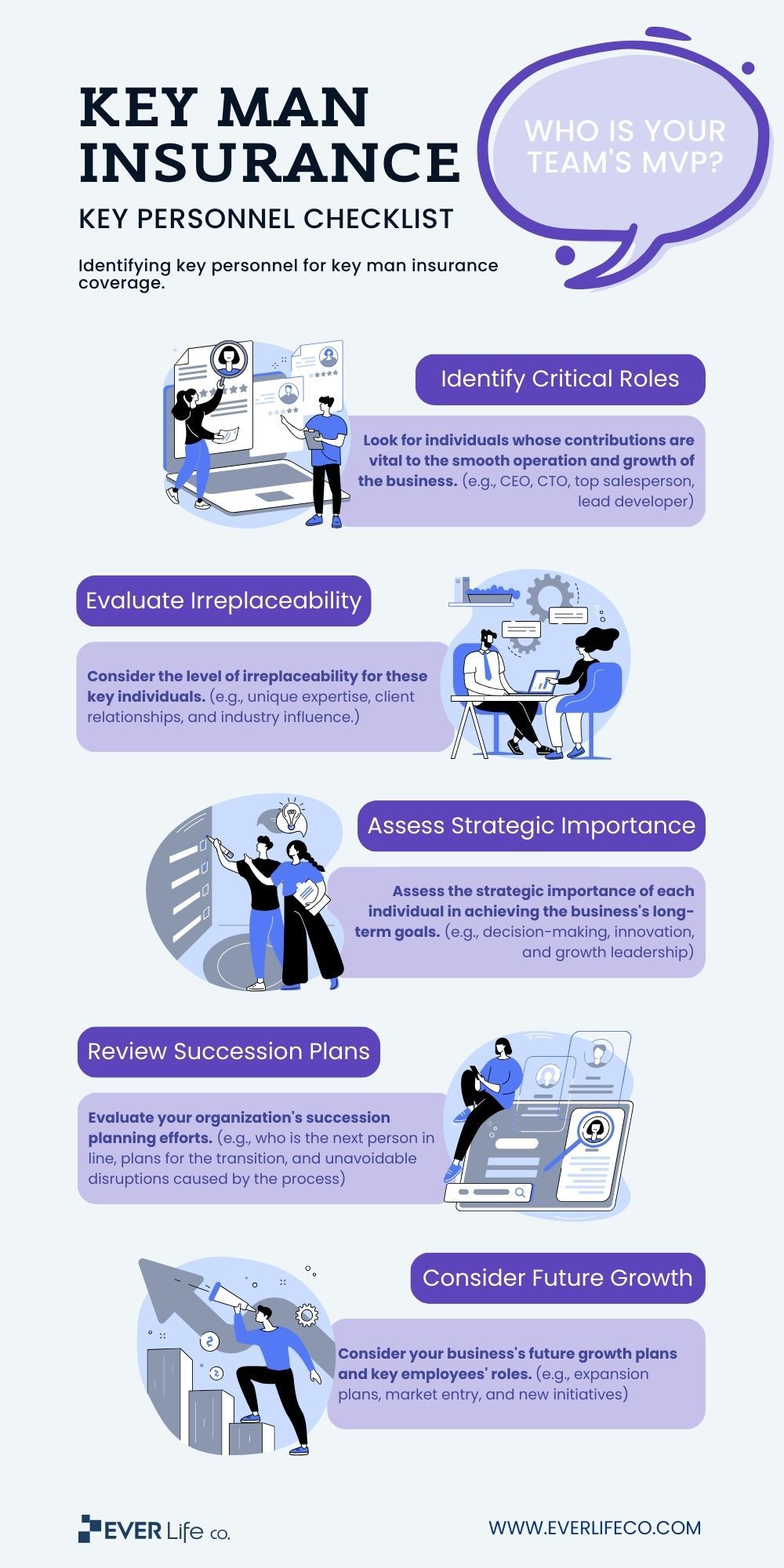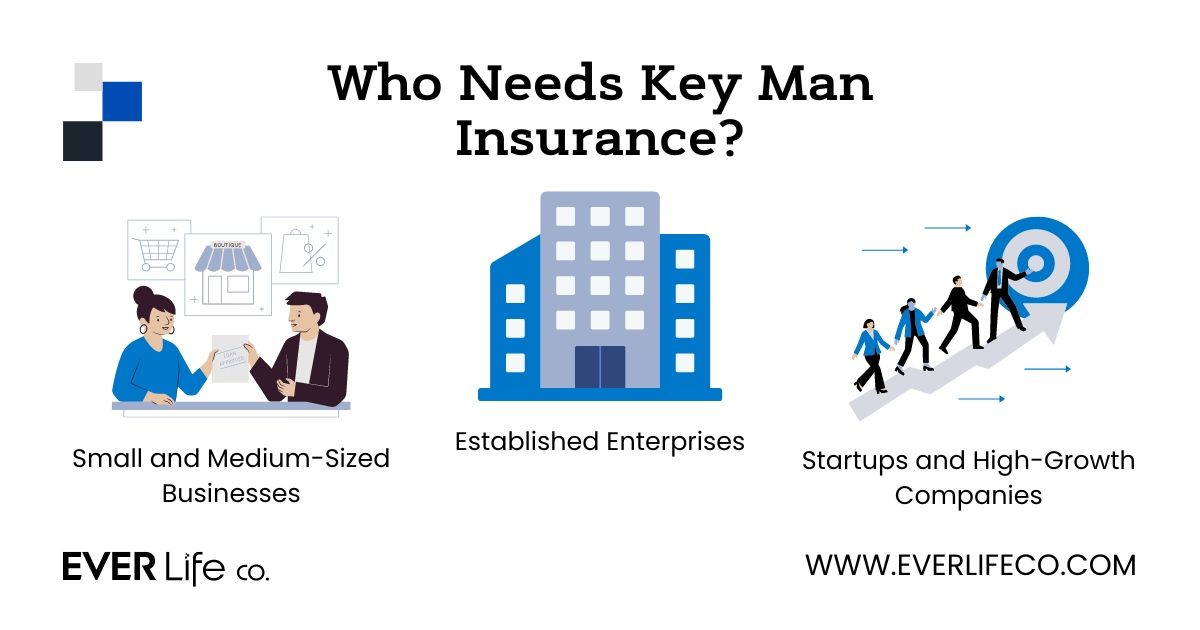
In the dynamic business world, one thing remains constant: the pivotal role played by key personnel. Whether it’s the visionary founder, the industry expert, or the exceptional executive, these individuals are the driving force behind a company’s success. But what happens if they’re suddenly unavailable? That’s where key man life insurance steps in as a financial safety net for businesses.
This article provides an in-depth review of key man coverage, explaining its definition, function, and significance for those who require it.
What Is Key Man Insurance and Why It's Important for Businesses

Definition and Purpose
Key man insurance, otherwise called key person insurance, is a specialized coverage designed to shield businesses from the financial consequences of losing key employees. It serves as a financial safety net, providing stability and reassurance during uncertain times.
Key Man Insurance Coverage and Benefits
The coverage options with a key man policy are as diverse as the businesses they protect. Its versatility covers a range of scenarios, including disability, critical illness, or the untimely death of a key employee.
With this coverage, businesses can safeguard their financial health, ensure business continuity, and even gain a competitive edge by showing stakeholders their commitment to mitigating risks.
Let’s delve deeper into the various coverage and invaluable benefits for businesses.
Key Coverage Options
Key Man Insurance policies typically provide the following coverage:
- Death Benefit: A lump sum payment to the business in the event of the death of a key person. This benefit covers the costs associated with recruiting a replacement, covering operating expenses, and maintaining the business’s financial stability.
- Disability Benefit: A regular income paid to the business in the event of the disability of a key person. This benefit covers operational costs and other business expenses incurred while the key person cannot work.
- Term Life Insurance: Key man policies are typically term insurance and offer coverage for a specific period and expire at the end of the term. Businesses typically set the coverage term based on the expected length of the key person’s employment with the company.
- Renewable Coverage: Key person policies are often renewable, offering the option to extend the coverage period at the end of the term without needing a new application or medical exam.
- Accelerated Death Benefit: Some policies include an accelerated death benefit, which allows the business to access a portion of the death payout while the key person is still alive if diagnosed with a terminal illness.
The Benefits of Key Person Coverage
Financial Stability
One of the primary objectives of key man insurance is to provide financial stability to a business in the event of losing a key employee. This stability is crucial to prevent the company from facing a sudden and severe financial setback.
The policy payout received covers expenses such as ongoing operations, hiring, and training replacement personnel, fulfilling financial obligations, or even compensating for a decline in revenue.
Business Continuity
Losing a key employee can disrupt the entire functioning of a business. Clients may grow concerned, employees may experience uncertainty, and projects may be delayed or compromised.
Key man life policy helps ensure business continuity by providing the necessary financial resources to bridge the gap during the transition period. It gives the business time to regroup, find suitable replacements, and maintain its momentum without succumbing to the pressures of sudden loss.
Creditor Assurance
Many businesses rely on external financing to support their operations or growth initiatives. In such cases, key person insurance coverage also acts as a safeguard for creditors.
With the policy in place, lenders or investors gain confidence that the business can meet its financial obligations, even if a key individual responsible for generating revenue or managing critical aspects of the company is no longer present.
This reassurance strengthens the business’s and creditors’ relationship, enabling continued access to crucial funding.
Employee Retention and Recruitment
Key man insurance is also pivotal in employee retention and recruitment strategies. Talented individuals often seek stability and security when choosing a company to work for.
By offering key man insurance coverage, businesses demonstrate their commitment to protecting their employees’ interests, instilling a sense of security and loyalty. Moreover, this coverage also serves as an enticing factor when attracting top-tier talent, distinguishing the business as one that values its employees’ well-being.
Competitive Edge
In today’s competitive business landscape, gaining a competitive edge is paramount. Key man insurance gives your business that extra edge.
You position yourself as a reliable and resilient organization by assuring clients, partners, and stakeholders that your business has taken proactive measures to mitigate risks. This level of preparedness and stability sets you apart from competitors, enabling you to win contracts, secure partnerships, and establish trust with stakeholders.
Seek Guidance for the Best Results
The coverage and benefits of key man insurance vary depending on the policy and insurer. Working closely with an experienced insurance professional or expert broker is crucial to tailoring the coverage to your business’s unique needs and ensuring that you maximize the benefits of investing in this type of policy.
How Key Man Insurance Works
Step 1: Identifying Key Personnel
Identifying the key personnel for coverage is a critical step in the process. These people hold essential positions in your organization. They have special abilities, knowledge, and experience that significantly impact the business’s achievements, earnings, and expansion.
Here are some fundamental considerations when identifying the crucial employees to be covered:
Contribution and Expertise
Look for individuals whose contributions are vital to the smooth operation and growth of the business. These may include founders, executives, top salespeople, technical experts, or professionals with specialized knowledge crucial to the organization’s core functions.
Assess their expertise, industry knowledge, and the areas where the absence of key contributors would substantially impact company operations.
Irreplaceability
Consider the level of irreplaceability of these key individuals. Are there readily available replacements within the organization, or would their departure leave a significant void that could be challenging to fill?
Evaluate whether the absence of a key employee would result in a loss of customers, damage to relationships, or a decline in revenue that would be difficult to recover from and proactively protect your business from the financial ramifications of their absence.
Strategic Importance
Assess the strategic importance of each individual in achieving the business’s long-term goals. Consider their involvement in decision-making, influence within the industry, and ability to drive innovation and growth.
Identifying individuals who significantly impact the business’s direction and success helps determine the risk associated with their absence.
Succession Planning
Evaluate your organization’s succession planning efforts. If clear successors are in place for key positions, it may mitigate some risks associated with losing key personnel.
However, even with a succession plan, there may be a transitional period during which the business could experience disruptions. Key person insurance can help bridge this gap and provide financial resources to support the transition.
Future Growth
Consider the future growth plans of your business. If you anticipate scaling up operations, entering new markets, or launching innovative services or products, it becomes even more critical to identify key personnel who will drive and lead these initiatives.
Ensure you have the necessary coverage to protect these valuable employees and mitigate risks during rapid growth and expansion periods.
Pinpointing these critical individuals requires a comprehensive understanding of your business’s unique dynamics and goals. This strategic approach to risk management provides peace of mind and strengthens your business’s ability to navigate uncertain times and maintain its trajectory of success.
It’s advisable to involve key stakeholders, such as executives, department heads, and human resources, in the identification process to ensure a holistic approach.

Step 2: Policy Creation
Once the business identifies its key personnel, it’s time to create a tailored coverage package. Factors such as the employee’s role, replacement cost, and the potential financial impact on the business are considerations for determining the coverage amount and policy terms.
Policy creation involves several vital steps to secure adequate coverage and protection.
Assessing Coverage Amount
Determine the appropriate coverage amount by evaluating the potential financial ramifications of losing an essential employee. Consider factors such as the employee’s contribution to revenue generation, their role in critical operations, and the cost of recruiting and training a suitable replacement.
While it can be challenging to quantify the exact value of an individual’s contributions, conducting a thorough assessment will help determine a reasonable coverage amount that aligns with your business’s financial circumstances and risk tolerance.
Policy Term
Decide on the policy term that suits your business’s needs. Short-term policies provide coverage for a specific duration, such as one to five years, while long-term policies may extend for longer.
Consider the time it would take to recover from the loss of critical employees, find suitable replacements, and stabilize operations. Longer policy terms offer greater protection and peace of mind but also come with higher premiums.
Insurance Provider Selection
Choose a reputable insurance provider with experience in offering key man insurance. Research and compare providers, assessing their financial stability, claims process efficiency, and customer reviews.
Seek recommendations from other business owners or consult an insurance broker specializing in key man insurance to find the most suitable provider for your specific requirements.
Policy Riders and Additional Coverage
Explore any available policy riders or additional coverage options to enhance your key man insurance policy. Riders provide additional benefits such as disability coverage, critical illness coverage, or accelerated death benefit options.
Evaluate these options to confirm they align with your business’s needs and financial goals.
Premium Determination
Several factors influence how much you’ll pay in premiums. These include age, overall health, the job position, the amount of coverage you choose, and how long you want your policy to last. Work closely with your insurance provider or broker to understand the premium calculation process and determine the best balance between coverage and affordability.
Obtain multiple insurance quotes to compare premiums and coverage options from different companies.
Policy Review and Maintenance
Regularly review your key man insurance policy to ensure it remains aligned with your business’s evolving needs. Periodically reassess the coverage amount and key personnel covered, especially during periods of growth, changes in management, or shifts in business priorities.
Stay in touch with your insurance provider to address any questions or concerns and inform them about significant organizational changes.
Step 3: Premiums and Claims
Understanding the factors influencing key man insurance premiums and the claims process is essential to make informed decisions and maximizing the benefits of a key person insurance policy.
Let’s examine these aspects:
Premium Determination
Insurance companies assess several factors when calculating premiums. These include:
- Age and medical history of the insured individual: Younger and healthier individuals generally have lower premiums as insurers perceive they pose a lower risk of disability or death.
- Occupation and level of risk: The nature of the insured person’s work and associated risks impact premiums. For example, individuals in hazardous professions may have higher premiums.
- Coverage amount and policy term: Higher coverage amounts and longer policy terms typically result in higher premiums.
- Business financials: Your business’s financial stability and performance may influence premiums. Insurers evaluate the economic viability of their commercial clients and industry trends to assess the overall risk.
Work with your insurance provider or broker to understand how these factors affect your premium calculations and find the right balance between coverage and affordability.
Claims Process
In the unfortunate event of the disability or death of a key person covered by the policy, the claims process ensures that your business receives the agreed-upon payout to mitigate financial hardships.
Here’s a brief overview of the claims process:
- Notification: Promptly inform your insurance provider about the event triggering a claim. They will guide you through the required steps and documentation.
- Documentation: Prepare the necessary documents, which include a death certificate, medical reports, or other relevant evidence to support your claim. Ensure accuracy and completeness to expedite the claims process.
- Claims Assessment: Once the necessary documents are submitted, the insurance provider will carefully review them to determine the claim’s validity based on the policy’s terms and conditions.
- Payout: Upon approval of the claim, the insurance company will initiate the payout according to the agreed-upon coverage amount. The funds will cover expenses, ensure business continuity, and mitigate financial impacts.
Who Needs Key Man Insurance?

Small and Medium-Sized Businesses
Small and medium-sized businesses are often vulnerable to the loss of key personnel. A National Association of Insurance Commissioners (NAIC) survey discovered that 71% of small businesses relied heavily on one or two individuals for success. Yet, out of those numbers, only 22% of the surveyed companies had key person life insurance coverage.
The absence of a key employee can disrupt operations, strain finances, and even jeopardize relationships with creditors. Key man insurance offers a lifeline, ensuring the business can weather the storm and thrive.
Startups and High-Growth Companies
Startups and high-growth companies face unique challenges. Often heavily reliant on visionary founders or key executives, their success is tightly intertwined with the talent that drives innovation. Often, these businesses suffer after the loss of a founder.
Key man insurance shields these companies from potential disruptions caused by the unexpected loss of their driving forces.
Established Enterprises
Even established corporations, with their vast resources and deep talent pools, are not immune to the need for key man insurance. In fact, the larger the company, the greater the potential financial impact of losing a key employee.
Key man insurance provides stability, ensuring the business can navigate turbulent waters and reassure stakeholders of its continuity.
Learn how to further secure your business with a buy-sell agreement.
Assessing the Costs and Benefits
If you remain on the fence about the necessity of key man insurance for your business, bear in mind these three things:
Cost Analysis
The cost of key man insurance varies based on the insured individual’s age, health, role at the company, and the desired coverage amount. While the premiums may seem like an additional expense, their protection and stability far outweigh the financial impact of not having coverage.
Risk Assessment
Conducting a thorough risk assessment is critical in determining key man insurance needs. Evaluating the potential financial consequences of losing a key employee, such as lost revenue, decreased productivity, or a damaged reputation, helps quantify the risks and highlight the importance of this coverage.
ROI and Long-Term Planning
Key man insurance isn’t just an expense; it’s an investment in your business’s future. Beyond immediate financial security, it brings long-term benefits by instilling confidence in stakeholders, ensuring continuity, and enabling strategic planning without the fear of unexpected disruptions.
Conclusion
In the ever-changing business landscape, the best minds who innovate, aspire, and motivate hold the keys to a company’s success. Key man insurance is the shield that protects your business from unforeseen circumstances and ensures its resilience in the absence of central personnel.
By understanding what key man insurance is, how it works, and who needs it, you’ve taken a proactive step toward securing your business’s most valuable asset. So, don’t wait for a storm to hit—act now and fortify your business with the protection it deserves.





